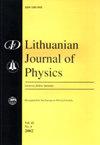半导体超晶格中的和频产生和放大过程
IF 0.3
4区 物理与天体物理
Q4 PHYSICS, MULTIDISCIPLINARY
引用次数: 0
摘要
半导体超晶格因其特殊的电子传输特性而成为非常著名的结构,使其在电子或光电设备中的应用极具吸引力。最近,由于在砷化镓/砷化镓超晶格中首次成功地实验证明了参量增益,从而产生了谐波、半谐波和分数谐波,人们对这种结构的兴趣进一步被激发出来。这一发明为成功实现太赫兹频率范围内基于超晶格的发生器和放大器铺平了道路。尽管实验结果不断涌现,理论研究也已进行了十年之久,但与超晶格内部物理过程有关的未决问题依然存在。最近,我们广泛分析了超晶格中退化过程的偏置效应,但直到现在,非退化情况仍未被纳入研究范围。在这项研究中,我们通过探索非退化过程的差异,进一步拓展了以往研究的范围。研究揭示了探针场与相对相位相关性的不对称外观,以及参数分数频率生成的可能性。最后,还预测并讨论了两个参与探针之间能量回流的概念。本文章由计算机程序翻译,如有差异,请以英文原文为准。
Sum-frequency generation and amplification processes in semiconductor superlattices
Semiconductor superlattices are very well-known structures due to their specific electron transport properties, making them extremely attractive to be employed in electronic or optoelectronic devices. The interest in such structures has been recently additionally stirred up due to the first successful experimental demonstration of parametric gain in GaAs/AlGaAs superlattices, resulting in the generation of harmonics, half-harmonics and fractional harmonics. This invention paves the way for a successful realization of superlattice-based generators and amplifiers up to the terahertz frequency range. Despite the emerging experimental results and decade-long theoretical research, unresolved aspects, related to the physical processes inside the superlattices, persist. Lately, the biasing effect was extensively analysed for the case of degenerate processes in the superlattice; however, the non-degenerate case was left out of frame until now. Within this research, we further expand the boundaries of previous investigation by exploring the differences of non-degenerate processes. The study uncovers the asymmetry appearance of the probe field vs. relative phase dependences as well as the possibility of parametric fractional frequency generation. Finally, the concept of energy reflow between two participating probes is predicted and discussed.
求助全文
通过发布文献求助,成功后即可免费获取论文全文。
去求助
来源期刊

Lithuanian Journal of Physics
物理-物理:综合
CiteScore
0.90
自引率
16.70%
发文量
21
审稿时长
>12 weeks
期刊介绍:
The main aim of the Lithuanian Journal of Physics is to reflect the most recent advances in various fields of theoretical, experimental, and applied physics, including: mathematical and computational physics; subatomic physics; atoms and molecules; chemical physics; electrodynamics and wave processes; nonlinear and coherent optics; spectroscopy.
 求助内容:
求助内容: 应助结果提醒方式:
应助结果提醒方式:


